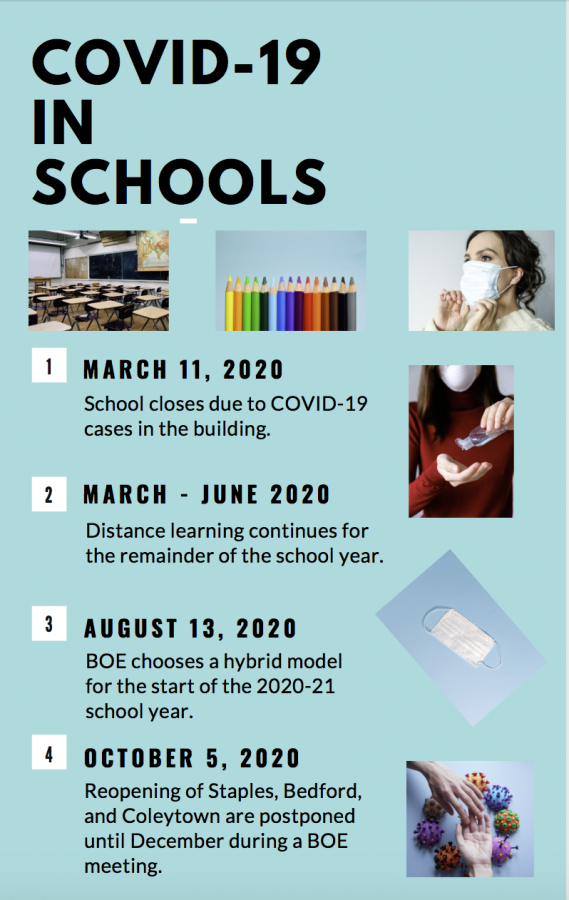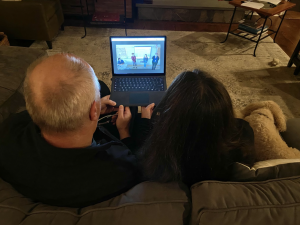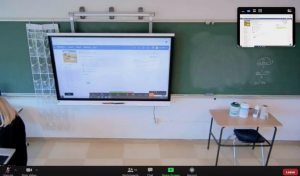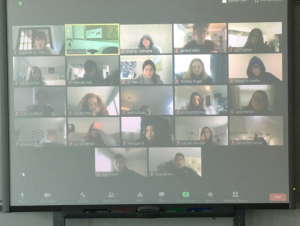Delayed reopening of Staples detrimental, requires reevaluation
Graphic by Anastasia Thumser ’22
The Westport school district has debated the most effective and safe way to handle the COVID-19 pandemic since March, when schools first closed in order to protect students and staff.
As I approach the sixth hour of my day spent staring at a computer screen, my eyes glaze over as I’m overcome with a wave of fatigue. I struggle to pay attention to the fourth bobbing head of a teacher I’ve seen during my day of distance learning, but the screech of a faulty microphone jolts me awake as I wince at the unpleasant noise.
Hybrid learning is the most practical method of education that Staples can partake in at this time, as it best considers the academic, social and safety needs of students and staff during the COVID-19 pandemic. Having said that, the half online, half in-person model is far from ideal, and I greatly look forward to a day when school can resume to the way we were once accustomed.
Unfortunately for me, returning to a fully in-person learning schedule does not seem to be happening in the near future. During the Oct. 13 Board of Education meeting, Superintendent Thomas Scarice recommended that the district remain in the hybrid model for the time being, with reevaluations occurring on a monthly basis.
It’s not lost on me that when developing education models during a global pandemic, safety is the foremost priority. Fully reopening a high school with approximately 2000 students in a COVID-friendly manner is no simple task, and the decision certainly shouldn’t be made spontaneously.
However, considering the drawbacks of distance learning and Staples’ stellar case-free record thus far, the timeline to contemplate resuming fully in-school learning should be moved up and reassessed bi-monthly.
Virtual classes at Staples are designed to mimic in-person lessons as closely as possible; however, it’s difficult to get the most out of my academics with the limitation of a screen. Technical difficulties are magnified over Zoom, as a finicky microphone or unstable Internet connection can interrupt a crucial part of the lesson and impede my understanding of a topic.
Furthermore, it’s unrealistic to expect teachers to be as adept at teaching virtually as they are in the classroom. Many teachers have decades of experience teaching with traditional methods, but have had to make do with mere months of practice navigating the nuances of Zoom learning.
Simultaneously teaching an in-person class and a virtual cohort is difficult to balance, and different teachers have various comfort levels when it comes to technology. As a result, students enrolled in the same courses will have a convergent learning experience, depending on their teachers’ proficiency with Zoom.
Distance learning also acts as a barrier between Cohorts A and B, which is not optimal for students’ social health. It’s a big adjustment for me to come to school and see the cafeteria only half as full as I’d expect it to be, but even when I go to class and see the other cohort on the screen, it’s practically impossible to interact with them. Involving the at-home group in an in-class discussion can be tricky, and if an activity such as a lab requires an in-person experience, the cohorts can be learning at a different pace.
One of the biggest factors in reopening Staples full time, according to Scarice’s recommendation, is the completion of Coleytown Middle School, which is not anticipated to be finished until December. Ideally, middle and high school students would resume traditional learning at the same time, but this plan cannot be approached until Coleytown opens in order to mitigate the overcrowding of Bedford.
While the situation in the middle schools is unprecedented, Staples shouldn’t be forced to follow the same timeline when it comes to reopening. Since the start of school on Sept. 8, there hasn’t been a single COVID case reported inside the building from either cohort. Social distancing measures appear to be going smoothly, and students have quickly adapted to the regulations required for safe learning.
There’s no reason why this can’t continue if both cohorts attend school full time. Supplementary planning will be necessary in order to ensure proper social distancing, but the current course of action to prevent an outbreak has been astoundingly effective so far.
Seeing as Staples is a separate entity from the middle schools and has not yet had a COVID case this school year, the timeline to reopen fully should be reevaluated twice a month. It is entirely premature to not even consider going back full time, and if the rate of transmission stays as low as it is now, a return of some academic normalcy may be closer in our reach than we thought.

Web Managing Editor Anastasia Thumser ’22 grew up as a writer, though the road wasn't easy.
“I kind of got off to a rough start in the class. It...
















































